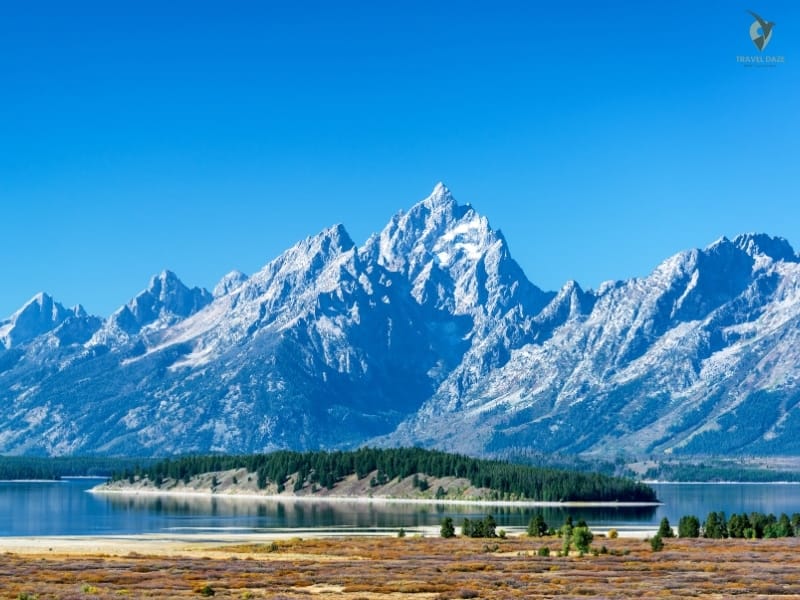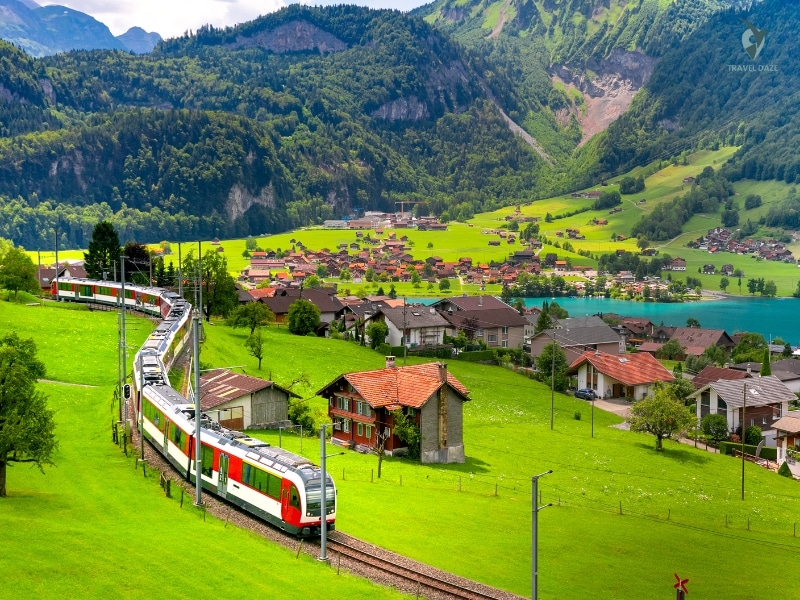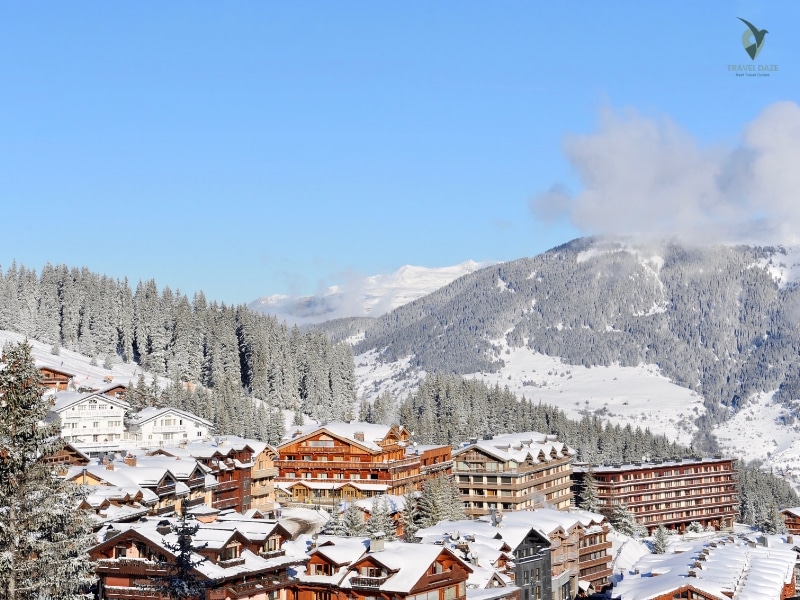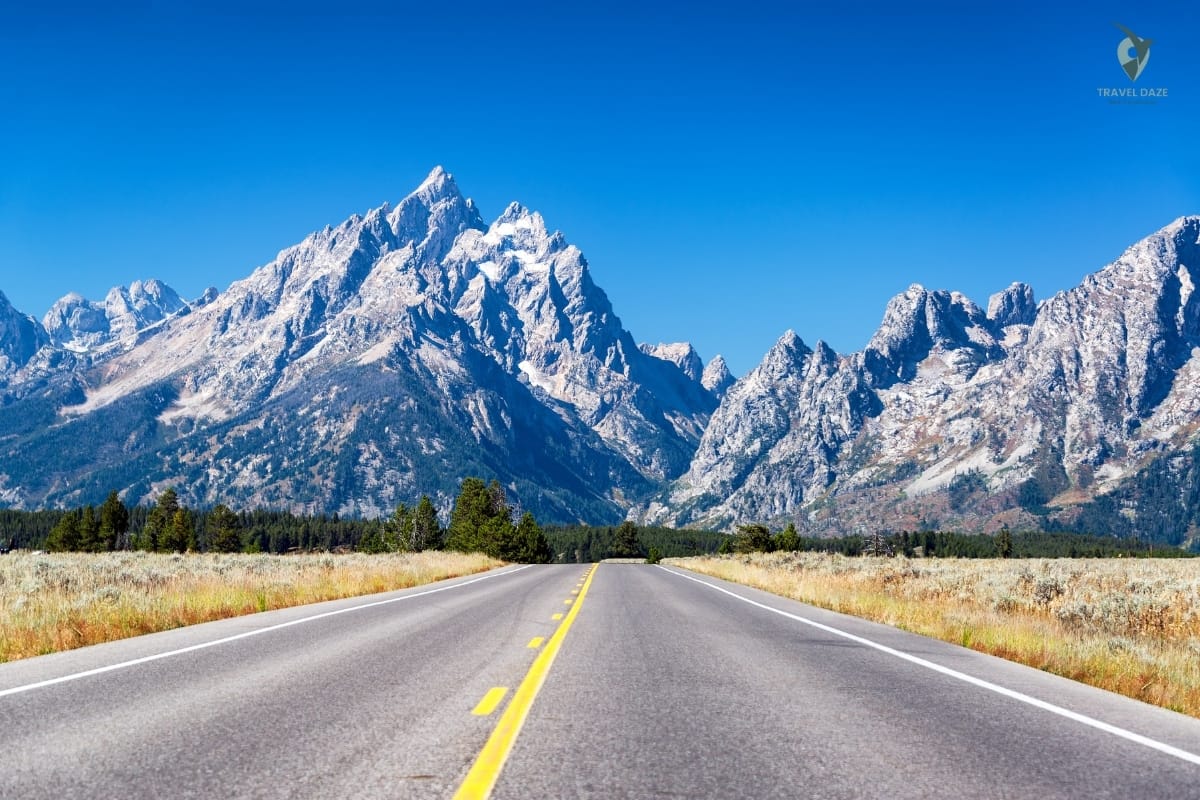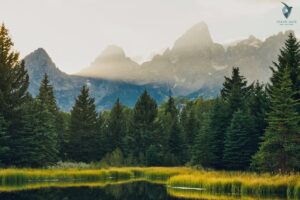Grand Teton National Park is stunningly beautiful, regardless of the time of year you visit. I have visited its alpine lakes, tall peaks, and green valleys in every season, and each trip feels like a new adventure. The park has beautiful scenery and a variety of animals, making it a great place for nature lovers to visit.
Table of Contents
ToggleThe best time to visit this national park depends on your interests. Do snowy trails and peaceful solitude appeal to you? Or do you like sunny hikes and lively wildlife? The park’s changes in height lead to different weather patterns, so it’s important to plan ahead for a good experience.
Main Points
- Grand Teton National Park provides special experiences throughout the year.
- The weather and wildlife activity change a lot with different elevations.
- Thinking ahead makes your visit easier and more enjoyable.
- Summer brings colorful wildflowers and busy trails.
- Autumn brings beautiful golden scenery and lively animals.
- Winter offers peaceful, snow-covered paths and a sense of calm.
- Spring brings back wildlife and beautiful flowers.
Enjoying the Changing Seasons at Grand Teton
Visiting Grand Teton National Park is like walking into a beautiful painting, particularly when the seasons change. Every season has its own charm, from the new flowers of spring to the warm colors of autumn. The park’s changing weather and variety of animals make each visit a fresh experience.
Spring Activities in the Tetons
Spring in the Tetons brings a sense of new beginnings. The snow starts to melt, showing muddy paths and some late-season snowflakes now and then. I’ve hiked in this changing weather, putting on layers to keep warm as temperatures go from 40°F to 60°F. Seeing the first wildflowers and spotting baby animals coming out of their winter homes is truly rewarding.
One of my favorite moments was watching a moose calf carefully follow its mother by a melting stream. The air is fresh, and the park is calm, providing a feeling of peace. Be ready for unexpected rain or snow—spring here can surprise you.
Autumn Colors and Amazing Animals
In the fall, the Tetons become a beautiful display of gold, red, and orange. The aspens and cottonwoods by the lakeshores make a beautiful setting for hiking and taking photos. I spent hours at Snake River Overlook, watching the sunlight play on the water and the mountains.
In autumn, wildlife becomes very active as animals get ready for winter. I’ve seen elk calling in the meadows and bears looking for food. The temperatures fall fast, going from 70°F in September to 40°F by November, so it’s important to layer your clothing. The cool air and bright colors make autumn my favorite time to visit the park.
Grand Teton National Park provides amazing experiences in every season, from the lively energy of spring to the peaceful beauty of fall. Bring your layers, take your camera, and enjoy the beauty of nature changing.
Summer Adventures: Hiking, Boating, and Wildlife Experiences
Summer in Grand Teton National Park brings endless adventure and lively experiences. The sunny, long days are great for discovering the park’s different landscapes. There are options for everyone, from beautiful alpine lakes to challenging trails.

Discovering Paths and Water Fun
Early mornings are perfect for hiking before it gets too hot. I have loved the trails close to Jenny Lake, where the views of the Teton Range are stunning. The fresh air and calm environment create a serene beginning to the day.
Boating on Jackson Lake is a great experience. Paddling on its clear waters gives a special view of the mountains. The peaceful mornings are great for seeing wildlife by the shore.
Thunderstorms often occur in the afternoons, so it’s a good idea to wrap up activities early. I’ve learned to plan my route well to stay dry during sudden rain. The fresh feeling after a storm makes being careful worthwhile.
Keeping Safe During Busy Times
Summer is the most active season in the park. Trails by the Snake River can become busy. For a better experience, I suggest beginning early and selecting quieter paths.
Seeing wildlife is common, especially bears and elk. Always maintain a safe distance and have bear spray with you. Being alert helps keep you safe and also protects the animals.
Even with the crowds, summer in Grand Teton is a memorable experience. The colorful wildflowers, lively animals, and beautiful views make it a place you have to visit. Gather your equipment, prepare in advance, and enjoy the journey.
Winter Wonderland: Skiing, Snowshoeing, and Peaceful Scenery
Winter turns Grand Teton into a peaceful, snowy wonderland. The park’s tall mountains and deep valleys create a peaceful escape, ideal for anyone looking for both quiet time and adventure. The quiet, snow-covered trails provide a calm getaway into the beauty of nature.
I really enjoy gliding along well-maintained cross-country ski trails. The fresh air and beautiful sights of the Tetons make each moment memorable. If you like a slower pace, snowshoeing through the calm forests is just as enchanting.
Wearing warm clothes is important for enjoying activities in cold weather. Put on waterproof clothing and strong boots to keep yourself comfortable. The calm beauty of the park in winter makes all the preparation worthwhile.

Suggestions for Enjoying Cold Weather Activities
Wake up early to enjoy the sunlight fully. Well-known paths such as Jenny Lake Trail look especially stunning when blanketed in snow. The frozen lake shows the mountains, making a beautiful view.
Seeing wildlife is uncommon, but it is a special experience. I’ve sometimes seen a bear or moose against the snowy background. Always maintain a safe distance and have bear spray with you for protection.
Winter in Grand Teton is like entering a storybook. The calm scenery and peaceful paths provide a special experience. No matter if you’re skiing, snowshoeing, or just enjoying the scenery, the park’s winter beauty is truly memorable.
Important Steps for a Pleasant Visit
When planning a trip to Grand Teton National Park, it’s important to prepare carefully for its changing weather and varied landscape. Being prepared for sudden rainstorms and quick temperature changes makes for a worry-free adventure. Here’s how to prepare and plan for a smooth experience.
Prepare for Quick Weather Changes
Bringing the right equipment is important for dealing with the park’s changing conditions. Begin with waterproof boots to ensure your feet stay dry on muddy trails or snowy paths. Wearing layers is essential—start with moisture-wicking base layers, add insulating mid-layers, and finish with a waterproof outer shell. Remember to bring extra socks; wet feet can spoil a hike fast.
Sturdy shoes are important for walking on foot trails, especially when the ground is uneven. When you’re driving, keep in mind that road conditions can change rapidly, especially during spring or fall. Make sure to look at the weather forecasts before you go out, and bring a reusable water bottle to keep yourself hydrated. Having extra supplies such as snacks, a first-aid kit, and a portable charger can be very helpful in unexpected situations.
Making reservations is important for popular places. Booking in advance, whether for a campground or a restaurant, helps you save time and guarantees that you have a spot available. Believe me, it’s really frustrating to arrive feeling tired and hungry, only to discover that there are no available tables or campsites.
Be ready for what makes Grand Teton special—its surprising nature. The weather can change quickly, so being flexible and prepared is important. With the right equipment and attitude, you’ll be prepared to handle anything the park presents to you.
Dealing with Mountain Conditions and Altitude Issues
The weather in Grand Teton can change quickly, from the valley floors to the high peaks. The park has steep hills and valleys that can be tricky, especially for people who aren’t ready for quick changes in temperature. I’ve experienced how fast a sunny hike can become a chilly adventure as you go higher.
Adjusting to Different Temperatures
The height above sea level greatly affects the weather in the park. As you go up 1,000 feet, the temperature can decrease by 3 to 5 degrees Fahrenheit. A warm morning in the valley can change to a cold afternoon on the trails. I’ve had this happen on hikes where I began in a t-shirt and ended up adding layers as I climbed to higher elevations.
When using park roads and trails, it’s important to be careful. Roads such as Moose-Wilson can be challenging, particularly when the weather changes unexpectedly. I’ve driven in fog that seemed to come out of nowhere, which reminds me to always check the weather before I leave.
Getting used to the high altitude is important. It’s a good idea to spend a day or two in the valley before taking on challenging hikes. This allows your body to adapt and lowers the chance of altitude sickness. Drinking enough water and taking Make sure to look at the weather forecasts before you go out. Isles can lead to a big change in temperature. I’ve walked on trails where the path went from dry to icy in just a short distance. Paying attention to these differences helps create a safer and more enjoyable experience.
The beauty of Grand Teton is unparalleled, but its weather should be taken seriously. Bring extra layers, stay aware, and enjoy the journey of dealing with its changing conditions.
Finding Unique Places and Uncommon Paths
Exploring the less traveled areas of Grand Teton shows a calmer, more personal side of the park. Although well-known places like Jenny Lake attract many visitors, there are many lesser-known trails and hidden spots ready to be discovered. These unique paths provide peace, beautiful sights, and chances to see wildlife up close.

Discovering Peace on Quiet Trails
One of my favorite secret paths is the Death Canyon route. This 8-mile hike goes in a loop, leading you through green meadows and thick forests, far from the busy areas. I frequently see moose eating by the creek, and their peaceful presence enhances the tranquility of the area.
Another great spot is the String Lake trail. Starting early means you’ll likely have the trail mostly to yourself, even if it’s not completely unheard of. The calm reflections of the Tetons on the lake create an ideal place for peaceful thinking.
If you’re looking for a longer adventure, the Paintbrush Canyon–Cascade Canyon Loop offers a tough but fulfilling 20-mile hike. I saw elk herds eating in the high meadows, their calls echoing through the canyon. The quiet here is unlike anything else, especially when you think about the more crowded paths.
Suggestions for Discovering Hidden Paths
To enjoy these unique adventures fully, begin early in the morning. This helps you stay away from crowds and boosts your chances of seeing wildlife such as moose and elk. Always take a trail map with you and look at the local conditions before you go out, since some paths might not be well-kept.
Finally, welcome the feeling of exploration. These hidden trails provide a special opportunity to enjoy the park’s beauty, away from the noise and crowds. Whether it’s a peaceful time by a hidden lake or a close meeting with a moose, these moments make Grand Teton truly unique.
Ideal times to visit Grand Teton: Seasonal advice for all travelers
Each month in Grand Teton National Park has its own special beauty and difficulties. No matter if you love snowy paths, colorful flowers, or the golden leaves of autumn, the park changes with the seasons, offering different experiences for every visitor. Picking the best month for your trip can really change your experience.
Selecting the Best Month for Your Hobbies
Every month in the park brings something unique. Here is a summary of what you can expect:
- June marks the start of summer, bringing blooming wildflowers and longer days. The trails are open, but more people are beginning to arrive. Make your plans early to get the best campsites.
- July is a lively time filled with activity. Wildlife is lively, and all facilities are available. Get ready for thunderstorms this afternoon.
- In August, the weather remains warm, but there are fewer people around. Now is a wonderful time for hiking and enjoying the lakes by boat.
- In September, fall comes with golden aspens and lively wildlife. Cooler weather is perfect for hiking and taking photos.
- October is calm and peaceful, with less crowding. Some places may close, but the fall colors are beautiful.
- November marks the start of winter, bringing quiet moments and snowy scenes. Snowshoeing and cross-country skiing are well-liked activities.
Jackson Hole, which leads to the park, also shows these seasonal changes. Summer is full of exciting events, while fall and spring provide more peaceful getaways. Choosing to travel during quieter weeks can make your trip more enjoyable.
Think about what you like to do and how fast you want to go when choosing the best time to visit. Summer is perfect if you enjoy hiking and seeing wildlife. Winter is ideal for being alone and enjoying the snow. Autumn brings a mix of beauty and calm.
Keep in mind that the weather in Grand Teton National Park changes a lot with the seasons. Make sure to pack what you need and look at the weather forecasts before you go on your trip. No matter if you stay for a week or a month, the park’s beauty will always amaze you.
Final Thoughts on an Unforgettable Grand Teton Trip
Thinking about my experiences in this national park makes me feel thankful and amazed. Every season had its own charm, from the colorful wildflowers in summer to the peaceful snowy scenes in winter. Seeing wildlife, such as a bear among the beautiful fall leaves, is a memory I will always cherish.
This park has shown me how to appreciate the unexpected gifts of nature. Every experience, whether it’s a sudden rainstorm or a peaceful moment by a hidden lake, feels like a special gift. To get the most out of your trip, it’s important to plan ahead, pack the right gear, and stay flexible.
I invite future visitors to discover with an open heart. The national park has something for everyone, regardless of the season. Let its beauty motivate you, and I hope your journey is as memorable as mine.
FAQ
What is the best season for hiking in Grand Teton National Park?
Summer is perfect for hiking, as trails are open and wildflowers are blooming. Be ready for crowds and afternoon thunderstorms.
Is it possible to visit during winter, and what activities can I do?
Of course! Winter brings skiing, snowshoeing, and peaceful scenery. Simply look at the road conditions and bring warm clothing.
What is the best time to see wildlife in the park?
In spring and fall, early mornings and late evenings are the best times to see elk, moose, and bears.
Are there any trails that are less crowded to explore?
Yes, trails such as Death Canyon and Taggart Lake usually have fewer visitors, providing a more peaceful experience.
What do I need to pack for a trip to Grand Teton?
Pack layers for quick weather changes, strong hiking boots, sunscreen, and enough water, particularly in the summer.
What should I do about changes in altitude when I visit?
Go at a comfortable pace, drink plenty of water, and allow yourself time to adjust, particularly when hiking in higher areas.
Is there a chance to go boating in the park?
Yes, Jenny Lake and Jackson Lake are great for kayaking, canoeing, and scenic boat tours in the summer.
What is the weather like in spring and fall?
Spring can be unpredictable with both snow and rain, while fall brings cooler temperatures and beautiful leaves. Always check forecasts before heading out.
Are campgrounds open all year long?
Most campgrounds are open from late spring until early fall. Winter camping opportunities are few, so make sure to plan ahead.
How can I stay away from crowds during busy times?
Get there early in the morning, check out some lesser-known trails, and try to visit during the week if you can for a quieter experience.

